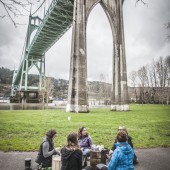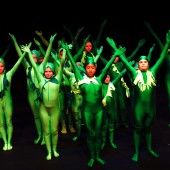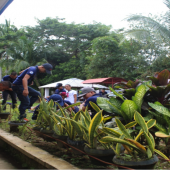Link: Table of Contents — Art, Social Change, and a Vision of Sustainability Sustainability – its meaning is often as elusive as the ideal itself. As an artist, sustainability can feel like a distant goal. Artists often struggle to maintain their professional practice while balancing physical well-being, spiritual and emotional wellness and healthy relationships with […]
Continue Reading
Upstream is an art project that builds connections and circulates stories among people who are linked to teach other through a common watershed. Experiences and memories about water are collected and shared through conversations over tea. Over time, these stories will help build common ground in communities where water can be a divisive issue.
Continue Reading
A sustainably-minded and technology-driven 2032 scenario was created to illustrate subtle attitudes and habits of characters based upon their collegiate informal learning and leadership experiences while earning an undergraduate degree. The creative scenario suggests that, based upon findings from a SLfSD (student leaders for sustainable development) study, leadership components may be identified and cultivated through informal educational avenues (i.e. student organization involvement) to help communicate and transition others to think and act in more environmentally-minded manners. The objective of the study was to explore the leadership components (leadership roles, personal capacities, and styles) of SLfSD. Quantitative, multivariate regression analysis of purposive sampling of student attendees of the 2013 AASHE (Association for the Advancement of Sustainability in Higher Education) revealed interesting influencers of leadership styles and personal capacities, including the interaction of gender, age, ethnicity, and leadership role (aspiring vs. formal leaders). This research suggests that SLfSD possess dynamic capacities and preferences that can impact the necessity for and effectiveness of sustainability-focused programming.
Continue ReadingMany migratory and native birds benefit from the habitat created by shade grown coffee plantations.
Continue ReadingI’ve got maps spread out
all over the kitchen floor
headwaters splintering into deltas

In my work on pollinators, I have been focusing on pollinators’ role within our food systems, and how human land use and agricultural practices threaten the diversity of native and non native species alike.
Continue Reading
This report describes artist Josh Winker’s Emerald Ash Borer Project in Minnesota, United States.
Continue Reading
In order to develop bioenergy into a viable industry capable of providing valuable energy and employment, there is an immediate need for a workforce prepared for the impending challenges of this emerging, interdisciplinary industry. To meet this need, it is necessary to identify and prioritize the topics that should be included in a college-level bioenergy curriculum. We implemented a three-round Delphi study to determine components of a college bioenergy curriculum in the US, by establishing consensus among a panel of American bioenergy experts. Round One consisted of a single open-ended question: Keeping in mind the future of a commercial bioenergy industry, what content knowledge should a student have upon completion of a college-level bioenergy curriculum? Responses were qualitatively coded into themes, and experts were asked to rate the importance of each theme using a five-point Likert-type scale during subsequent rounds. The final round resulted in 13 themes: Energy Basics, Types of Bioenergy, Environmental Impacts (including Life Cycle Analysis), Current Technologies, Societal Issues, Logistics, Policy, Biomass Composition, Non-Bioenergy-Specific Fundamentals, Biomass Production, Conversions, Bioenergy Market, and Business-Related Knowledge. Results will be used to bolster the existing bioenergy education initiative at Oregon State University, and can provide guidance to other institutions in the US and abroad interested in developing similar bioenergy education programs.
Continue Reading
For my culminating master’s project, I attempted to apply carefully selected theories and research to guide the production of a five-minute video trailer for a potential future documentary titled Children of Change. The video project endeavors to illustrate the myriad ways families and children in the United States are impacted by climate change, including proximity to the processes that contribute to climate change such as fossil fuel extraction, transport, and consumption; how the climate issue is inextricably tied to and will continue to exacerbate existing systems of oppression at home and around the world; and how our children’s health and future well-being are most at risk. Children of Change also documents how parents, youth, and families are engaged in the fight for their lives.
Video can be viewed at: https://vimeo.com/226170224

I created Shine, a mini-musical performance for 4th-12th grade students that uses theatre to explore issues of sustainability. It weaves climate science and artistic expression into a funny and powerful story that spans three hundred million years of geological time to convey the relationship between energy, humanity, and climate. Rehearsing each song in this half-hour musical immerses youth in the issues surrounding climate and energy and leads participants in embodying different aspects of climate science and human development that brought us to this point– where our use of fossil fuels is impacting our climate. The first half of the show is professionally scripted, composed, and choreographed to tell the story that has already been told by history. The second half—our future story– is made up of skits authored by local youth to generate solutions for their community’s sustainability challenges. A final song and dance celebrates this achievement and embeds the spirit of commitment into the catchy tune that students will be singing for perhaps decades to come.
Continue Reading
Here we describe how science learning can be enhanced through filmmaking. Combining the creative process of film production and its engaging storytelling and artistic components with science learning allows students to take ownership over their learning process and makes science accessible to learners who might not be reached through traditional science classrooms. We describe a model in which students develop a short film that investigates how climate and environmental change impacts their lives and their communities. Students are guided by college student mentors or teachers through a five-step program that includes: (1) selection and research of their topic, (2) development of a storyboard and script, (3) filming, (4) editing, and (5) a capstone screening event showcasing the final film. Through this process, students deepen their understanding of climate science and its complexity, while increasing their appreciation of the impacts of climate on society. Students also gain exposure to science and technology careers, while gaining confidence in their ability to complete a project.
Continue Reading
The participation of youth in any disaster risk reduction activities could be enhanced when they have high levels of awareness on climate change. But there seems to be scanty information about their level of awareness. The study was conducted to investigate the level of awareness of youth studying in a state university in the Philippines, and to determine the factors that influenced their awareness. The study employed the descriptive survey method using a 5-Lickert scale instrument involving the students of Partido State University (PSU), Camarines Sur, Philippines. Respondents (n = 247) were selected randomly from the undergraduate student population, and were stratified by their year levels. Although there was no qualitative difference observed among the respondents, the computed weighted mean for all variables under investigated differ across year levels. Based on the computed weighted mean, level of awareness is generally higher among senior students than first year students. Similar observations were made for all variables, i.e. computed weighted means increase as year level increases. In addition, the factors perceived to be significantly influencing the level of awareness of the respondents have differed across year levels. First year students perceived personal experience while second and third year students as well as fourth year students perceived education and government actions, respectively as much important factors that could influence their level of awareness. The channels of information about climate change also differ across year levels based on the computed weighted means. Among the four channels presented in the survey, first and second year students perceived mass media and family and trainings and seminars, third year students perceived internet and social media, and fourth year students perceived education, mass media and family and trainings and seminars as important channels of information. Overall, the differences could be utilized as bases in developing academic as well as extracurricular activities that are sensitive to the sex and year level of the involved students to improve their cognitive adaptive capacity.
Continue Reading